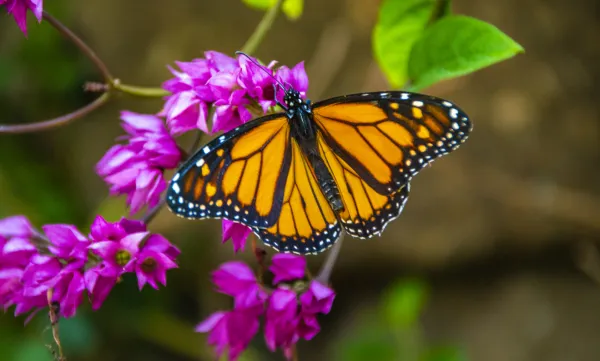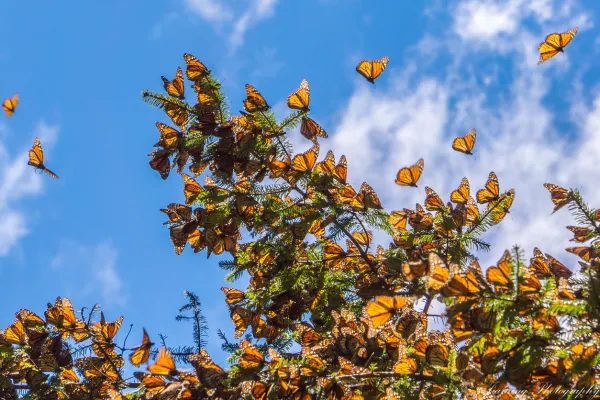Famous for its multi-generation migration from the United States and Canada to Mexico and coastal California, the monarch butterfly is now in trouble. The migratory North American population has been assessed by the IUCN as Endangered (status updates are periodic; always check the latest assessment).

(Danaus plexippus plexippus · family Nymphalidae)
Why the monarch is becoming endangered
Monarch traits, habitat & life cycle
How to prevent monarch extinction (actions that work)
FAQs
Key takeaways
Temperature extremes: Colder winters and hotter summers increase mortality and push suitable habitat northward.
Droughts: In breeding areas (U.S. & Canada), drought raises adult death rates and reduces milkweed (host plants for caterpillars), yielding fewer migrants.
Phenology mismatch: In spring 2012, unusually warm U.S. temperatures triggered early northward migration—before milkweed had emerged. In 2013, colder-than-normal conditions delayed northward movement.
Disease spread: Warmer conditions favor parasites and pathogens (e.g., OE protozoan), compounding declines.
Alarm bells: In 2013, Mexico recorded the lowest overwintering population in 20 years—about 35 million butterflies occupying ~1.7 ha, compared with ~45 ha in 1996.
Wintering sites (central Mexico’s montane forests; California coast): impacted by heavy tourism, illegal logging, and local agricultural expansion. In California, eucalyptus stands (notably Eucalyptus globulus) used by roosting monarchs have been reduced by logging.
Breeding grounds (North American prairies & farmlands): widespread herbicide use has erased milkweed across huge areas (in parts of the West, an estimated ~97% of milkweed in prairie lands was gone by 1999), eliminating the caterpillars’ only food source.
Bottom line: Degraded winter habitat + disappearing milkweed + weather extremes = decades of decline.
Native range & spread: Native to North and South America; also introduced to Australia, New Zealand, Mauritius, several Pacific islands, and parts of western Europe.
Migration: Annual journeys of ~1,900–4,500 km. Eastern monarchs overwinter in central Mexico; western monarchs on the California coast.
Core winter refuge: Monarch Butterfly Biosphere Reserve (Mexico)—56,259 ha of protected mountain forest. In peak years, up to a billion eastern monarchs have clustered there each autumn.
Generational relay: Adults live ~4–5 weeks. They mate before the northbound trip; females lay eggs on milkweeds (Asclepias spp.) at breeding grounds. Egg + larva ≈ 2 weeks, then pupa (chrysalis) 9–15 days. The butterflies that return north are the offspring (2nd–3rd generation) of those that departed.
Diet & defense:
Larvae eat milkweed and store cardenolides (cardiac glycosides).
Adults feed on nectar.
Bright orange-red wings with black veins and white spots are warning colors to deter predators.
ID tip: Males have a scent patch (black spot) on each hindwing and thinner veins; females show thicker wing veins.

Wintering areas (Mexico/California): Support legal, sustainable forestry and eco-tourism; curb illegal logging and unmanaged visitation; retain/restore suitable roosting trees (eucalyptus and native conifers/broadleaf mixes).
Breeding areas (U.S./Canada):
Reduce broad-spectrum herbicides; keep milkweed corridors in and around farms, rights-of-way, and parks.
Create nectar corridors in schools, parks, campuses, and neighborhoods.
Use native milkweeds appropriate to your ecoregion (e.g., A. syriaca, A. speciosa, A. incarnata, etc.).
Avoid tropical milkweed (A. curassavica) in temperate zones—or cut it back in late fall—to prevent overwintering traps and higher OE parasite loads.
Provide season-long nectar (spring–fall) with native flowers (coneflowers, bee balm, goldenrods, verbenas, etc.).
Skip neonicotinoids and other broad-spectrum insecticides; minimize herbicide drift.
Prefer physical/biological controls (hand-picking, barriers, beneficial insects).
Leave some leaf litter and stems over winter as shelter for insects and pupae.
Join tag-and-recapture, migration counts, and overwinter colony monitoring.
Submit sightings to local nature centers or national platforms to improve annual population assessments.
Back prairie and corridor programs (e.g., roadside/powerline pollinator plantings).
Bring monarch lessons and pollinator-garden projects to schools and communities to build long-term support.
Why do monarchs migrate “by relay”?
Adults live only 4–5 weeks. Completing the full round-trip requires multiple generations, each handling a different leg of the journey and breeding along the way.
What should we plant at home or school?
Your native milkweed species plus continuous nectar plants. In temperate regions, avoid or cut back tropical milkweed in late fall to reduce disease risk and migration disruption.
Why are herbicides such a big problem?
Caterpillars eat only milkweed. When herbicides wipe milkweed from vast areas, larvae have no food, and populations fall.
How do I watch butterflies without harming them?
Keep a respectful distance; don’t handle larvae or pupae; avoid blocking sun on chrysalides; leave “wild corners” for insects in schoolyards and parks.
Main threats: climate change (heat/cold extremes, drought, disease), winter habitat degradation, milkweed loss from herbicides, logging/tourism pressure.
Signature traits: multi-generation migration 1,900–4,500 km; caterpillars monophagous on milkweed; adults show orange-black-white warning colors.
Do this now:
Plant native milkweed + season-long nectar; manage tropical milkweed responsibly.
Reduce pesticides and herbicides; use wildlife-friendly gardening.
Support wintering-site protection and prairie/corridor restoration.
Join citizen-science monitoring and community pollinator gardens.
Observe responsibly—no collecting, no disturbance.
animal tags: monarch butterfly
We created this article in conjunction with AI technology, then made sure it was fact-checked and edited by a Animals Top editor.